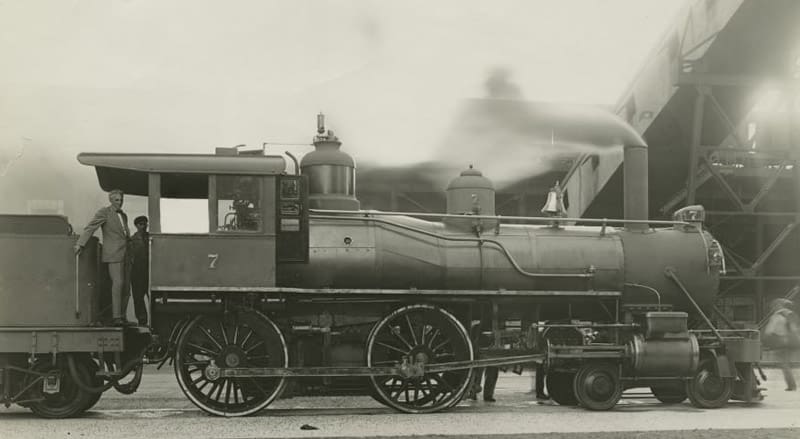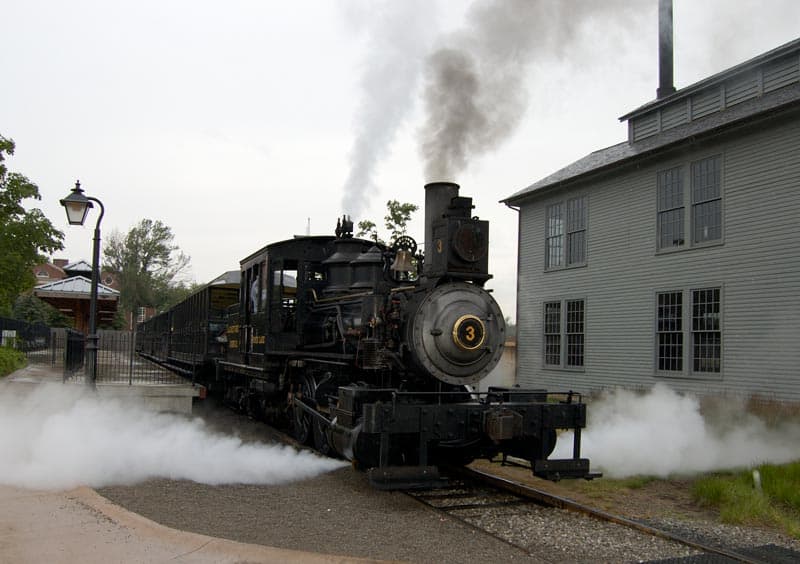Henry Ford Museum, Static and Operational Steam in Michigan
Known as the ‘Father of the automobile’, Henry Ford played an integral role in the development of transportation technology in the late 19th and early 20th centuries, but his contributions didn’t stop there. In fact, Ford was a huge supporter of railroad operations. Now named after the founder, The Henry Ford Museum of American Innovation (“The Henry Ford”) showcases items of historical and cultural significance to America with an interactive historical village including an operational heritage railroad on the museum grounds.

Henry Ford’s Ties to Railroading
His First Real Job Was Making Train Cars
Born in July 1863, Henry Ford grew up on a farm in Dearborn, Michigan, outside of Detroit. Though raised on the farm, Ford did not envision himself as a career farmer. When he was 12, the investigative young man received a pocket watch from his father which he disassembled and put back together.
When he was just 16, Ford left home to become an apprentice machinist in Detroit. He began working at James F. Flower & Bros., a machine shop that produced train cars among other items. After a couple of years, Ford moved on to the Detroit Dry Dock Company because he felt the new opportunity would allow him to learn more about heavy machinery.
Eventually Ford would return to the family farm to help his father. Even though he did not enjoy the farming lifestyle, Ford would fix broken equipment and tinker. This just furthered his interest in building and enginering.
A Position at Edison Sets Ford’s Trajectory
After nearly a decade back on the farm, Ford pursued a job with Edison Illuminating Company in 1891 as a night operating engineer at one of the company’s substations. During his time on the farm, Ford developed skills for repairing and building equipment. Ford saw the position with Edison as an opportunity to learn more about electrical engineering.
In 1892, Ford was put in charge of maintenance of Edison’s steam locomotives at the main facility in Detroit and a year later he was named Chief Engineer. In 1896, Ford attended a meeting with company executives including Thomas Edison. Edison supported Ford’s work, giving Henry the confidence needed to push forward.
He Owned a Railroad
Like most manufacturing companies, the Ford Motor company often depended on railroads to deliver raw materials as well as transport finished goods. One railroad that Ford saw as vital to the company was the Detroit, Toledo and Ironton (DT&I) as the line gave Ford access to other major routes throughout the Midwest.
In 1920, Ford purchased the DT&I for $5 million (the equivalent of close to $100 million in 2022). Interestingly enough, Ford sought to electrify the railroad and purchased several pieces of electrical equipment over the years.
Once under Ford’s control, the railroad would implement several upgrades that would help efficiency and profitability. In nine years under Ford, the previously bankrupt railroad was highly successful. Ford elected to sell the railroad in 1929 in part to what he considered to be ‘over-regulation’.
During his ownership period, Ford enjoyed riding behind the former Detroit & Lima Northern #7 and the locomotive is often considered to be Ford’s “personal” locomotive.

The Henry Ford Museum
While Ford unloaded the DT&I in 1929, he also witnessed the opening of the Edison Institute, which would eventually become ‘The Henry Ford’. Named after Ford’s mentor, the facility was originally used for private research. The collection grew over the next several years with donations coming from Ford’s personal collection among them. By the mid 1930s, interest was strong enough that the museum opened to the general public.
A Car Museum? A Railroad Museum!
It would be reasonable for one to expect The Henry Ford to have a wide exhibit of automobiles throughout the years, but visitors are often surprised by the representation that railroad history has throughout the museum. The railroad exhibit in The Henry Ford features five historic steam locomotives including a replica of the Stephenson “Rocket” and the rebuilt “Sam Hill”, both of which were supervised by Ford.
Allegheny Gives Museum Mountainous Problem
Known for having unique items, The Henry Ford received a huge donation in 1956 in the form of the recently retired C&O #1601, a 2-6-6-6 (Allegheny type). The museum had the exhibit area planned out and everything was going to plan… until they attempted to move the locomotive into the museum.
Eventually the museum was able to get the massive Allegheny on display. In order to do so, the move took three attempts and actually required an opening on an outside wall of the building to be enlarged.

Weiser Railroad Brings History to Life
While the museum has a wide collection of historical railroad items inside, the experience is taken to a new level at the attached Greenfield Village which includes the Weiser Railroad heritage line. Designed to feel like a historic railroad operation, visitors to the village will notice a roundhouse and coal tower that are both actively used by the railroad.

Although there was a section of straight track on the property when the facility opened in 1929, the railroad would not be built into its current form until 1972. Operating seasonally when the Greenfield Village is open, the Weiser Railroad takes visitors back to the steam era as the two mile excursions are led by authentic locomotives that from the steam era. There are currently three steam powered locomotives that lead passengers around the rails:
- Torch Lake #3 is a 0-6-4T locomotive built by Mason Machine Works in 1873. The locomotive was donated to the museum in 1969 and entered heritage service after a two year restoration.
- Edison #1 features a 4-4-0 wheel arrangement, though the locomotive originally featured a 0-4-0 setup when built in 1870. While some incorrectly attribute the “Edison” name to Ford’s ties to Thomas Edison, the locomotive actually received its name via a previous owner, the Edison Portland Cement Co. The locomotive’s wheel setup was changed at the order of Henry Ford after he purchased the locomotive in 1931.
- The previously mentioned D&LN #7, also a 4-4-0, is the youngest of the operating locomotives on the Weiser Railroad. Built in 1897 by Baldwin Locomotive Works, #7 was retained by Ford when he sold the DT&I and subsequently donated to the museum.

Final Thoughts
Nearly 90 years after the Edison Institute opened to the public, the museum continues to honor Henry Ford’s goal to preserve American history. In addition to the wide collection of railroad pieces, the museum has important American artifacts including the chair Abraham Lincoln was sitting in at time of his death, JFK’s limousine, and an original Model T.
It is clear that the museum goes to great lengths to preserve the artifacts in their collection, as evidenced by the collection of locomotives still steaming after more than a century. If you want to learn more about the museum, including the locomotive collection, head on over to The Henry Ford website.

